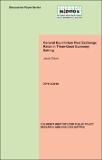| dc.description.abstract | This study develops a theoretical general equilibrium model of the
determination of the equilibrium long-run real exchange rates in a
three-good open economy framework. Three economic agents are
considered in the model: a representative consumer, a representative
firm, and the government sector. Two goods are produced by the
representative firm: a non-tradable good, and an exportable good
while the consumer demands two goods: the non-tradable good, and
an imported good. The three agents interact in an internal-external
equilibrium framework. Comparative statistics from the developed
equilibrium long-run real exchange rate show that the long-run real
exchange rate depreciates as government spending on the traded goods
increases, and it appreciates as foreign interest rates increase. On the
other hand, an increase in the world interest rates appreciates the
real exchange rates, while an increase in capital outflow depreciates
the real exchange rates. In general, this study adds to the existing
knowledge of the determination of the long-run real exchange rates by
suggesting that the real sector variables, including the capital labour
ratio, are important determinants of the long-run real exchange rates. | en |

